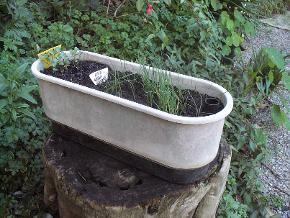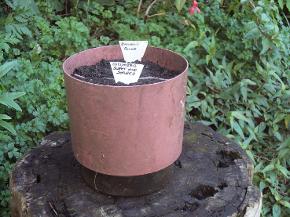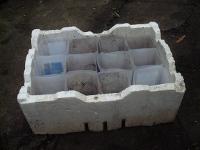Success with seeds and seedlings
It is not always easy to grow your own plants from seed, or even when you buy a punnet of seedlings.
Forgetting to water them can be tragic, and snails can happily munch through all your newly planted seedlings
in one night.
Here are some suggestions for minimising losses.
Growing from seed
Self watering pots are excellent for growing plants from seed.
Two-thirds fill the pot with potting mix and some good quality
organic plant food. This will provide plenty of nutrients for the
seedlings as they grow. Top this with seed raising mix and sow the
seeds according to the instructions on the seed packet.
Small seeds can be sprinkled on top and covered lightly with seed
raising mix. Larger seeds need to be planted more deeply.
Several types of seeds can be sown into large pots but remember to
label each patch!
Gently water the seeds in and fill the pot's reservoir. The soil will be
watered from below, and as long as the reservoir doesn't dry out,
the seed will remain moist.
A small greenhouse made from a large, clear plastic bag placed
over the pot and supported on hoops of bent fencing wire will keep
the pot warm and hasten germination. Alternatively, put the pot in a
sunny spot indoors until the seedlings are up.
Transplant when each seedling has about 4 'adult' leaves.


Seedlings
Small seedlings planted into the garden can disappear overnight if snails and slugs find them. Potting them up
first, then planting them out as advanced seedlings can give them a better start. Except for transplant shock:
they can suffer a set back if their roots are too disturbed. The following technique minimises root disturbance
when the seedlings are planted out.
(Thanks to Linda Woodrow, author of 'The Permaculture Home Garden' for this idea.)
Note: Some seeds are best sown direct into the garden bed as the seedlings will sulk if transplanted. This
applies to most root crops eg. carrots, parsnips, turnips, beetroot. With these you will just need to be extra
vigilant with watering and snail collection.
Use 2 litre milk bottles to make bottomless pots.
Cut off the top and bottom of the bottle.

Twelve milk bottle pots fit snugly into a polystyrene vegetable box.
Fill with your best potting soil and plant a seedling into each pot.
The polystyrene box insulates the growing seedlings. Place it in a warm, sunny spot and keep well watered
but not sodden. Some water storage crystals will help retain moisture in the potting soil.
As with the seed pots, covering with clear plastic will keep the seedlings warmer on cold days and nights, and
speed up growth. But do be careful on hot days.
When seedlings are about 15 cm tall (more for tomatoes*) they can be planted into the garden. Dig a hole the
size of the milk bottle pot and carefully drop the plant into the hole, sliding the pot off as you do. Firm the soil
around the plant. Water in with liquid seaweed solution eg. Seasol and mulch well. The pots can be re-used
many times.
*Plant tomatoes deeply. Carefully remove the lower leaves and plant about halfway up the stem. Roots will
grow from the nodes on the buried stem section.
Bean and pea seeds can be sown direct into the pots, 4 - 5 seeds in each. Use potting mix with no added
plant food. Plant into the garden when about 15cm tall. Don't separate the seedlings, plant them direct from
their pots in their groups of 4 - 5.
Snails and slugs can still be a problem, but at least you'll get some warning before your 'babies' are totally
demolished.